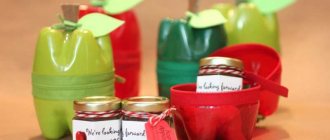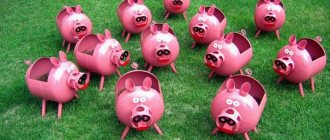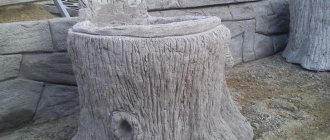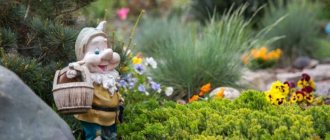Sometimes you really want to surprise others with something outlandish. A do-it-yourself castle in the country is an image from a fairy tale that captivates with its grace and at the same time simplicity. The miniature structure creates a romantic mood even in adults, not to mention children.
Figure 1. A decorative stone castle will be a great addition to a rock garden or alpine slide.
A small castle, built with your own hands, is currently included in the idea of the design of a suburban area. Various castle projects fit perfectly into the European style of landscaping private property. A miniature structure can become the center of a children's playground, or it can simply emphasize the romantic nature of the inhabitants of the dacha.
Features of mini locks
You can make a small castle from leftover concrete, putty, paint and boards.
A mini-castle in a dacha is a small architectural form for landscaping a dacha or other suburban area. The main objectives of the building are to enhance aesthetic perception and emphasize a certain design style.
Often such an element serves as a children's attraction. Castles can be made in the form of an exact copy of famous historical buildings from knightly times or built according to a specially developed plan.
In terms of placement, a mini-castle often becomes a separate element of a dacha design, built on a specially designated area, but more often it is used as an element of a composition, being part of a flower garden, fountain, spring, or children's playground.
Buildings can also differ in technical solutions - simple (only the building itself) and complex, including special multi-colored lighting (or even light music) with electronic elements.
Rainbow butterflies over a flowerbed
We cut out such butterflies from plywood - for this you will need a jigsaw (or better yet, a jigsaw). To turn the blanks into beautiful butterflies:
- sand the edges with sandpaper;
- We apply wood impregnation to the workpieces on both sides to protect them from moisture;
- apply primer;
- paint with wood or acrylic paints;
- after the paint has dried, apply varnish for external work;
- We fix the butterflies on long rods.
In the same way, you can make large fancy flowers - they will greatly enliven the lawn.
Construction material
The construction of castles can be made from a wide variety of building materials, as well as improvised means. Buildings of different sizes made of stones are widespread, and both refined (marble, granite) and wild, natural stones (for example, pebbles) can be used. Such building materials are usually fixed using cement mortar, but sometimes clay, lime or gypsum compounds are used, as well as standard building mixtures.
Lanterns along the sidewalk can be decorated in the form of a tower.
Many decorative castles are built by pouring concrete. To carry out such projects, small formworks are installed. The main advantage of concrete buildings is durability, strength, moisture resistance and fire safety. For small houses, concrete reinforcement is not necessary, but for large houses, reinforcing mesh can be used.
It is difficult to do without wood when creating small architecture. Wooden parts are easy to process and can be given any shape. The need to treat with an antiseptic makes it difficult to use. Many locking elements have to be made of sheet metal, giving it a cylindrical or conical shape.
Polystyrene foam is used as a building material. This material with a dense structure, when cut, becomes small bricks for constructing a building or blocks that form an entire wall. You can use different types and sizes of plastic. Various available materials are widely used - bottles, pipe cuttings, parts of old household appliances, etc. It is difficult to list all the materials that are used in construction; it all depends on the imagination of the performer.
Decorative balls or lamps
Let's make spectacular hanging balls to decorate the garden or lamps with round lampshades. The manufacturing principle is simple:
- inflate a large balloon or take a soft ball;
- wrap the ball or ball with twine (twine), secure it with PVA glue.
- You can paint the twine before treating the workpiece with glue, or when it hardens.
- We pierce the ball/ball inside and take it out.
- Cover the ball with varnish.
- If instead of twine you use thin and flexible colored wire. the work will be done even faster, and the decorative ball will last a long time - despite the wind and rain.
Structural elements
These castles were built at different times and therefore had slightly different styles. Most often, the concept of castle architecture is associated with the Gothic style, characterized by various spiers and pointed roofs. With all the variety of styles, the characteristic structural elements of locks can be distinguished:
Figure 2. You can place a flower bed inside the castle walls.
- Hill and moat: castles were built using natural protection - a hill (hill, mountain) and were surrounded by a moat with or without water.
- Courtyard: A protected area within a fortress wall, often containing outbuildings and housing for guards and servants.
- Donjon: the central tower of the castle for the owner to live in - a fortress within a fortress; The shape of the donjon was different - quadrangular (England), round, polygonal, irregular in shape.
- Fortress wall: a high wall with battlements at the top to shelter soldiers and with loopholes.
- Defensive towers: similar to the wall, they had battlements and loopholes, most often they were round, but square shapes were also used, they were always located at the corners of the wall and in the middle part.
- Gates: to strengthen security, they were equipped with watchtowers; the entrance was usually blocked by an arch; a mandatory element was a drawbridge.
The layout of the castle territory itself depended on the terrain and had a triangular, rectangular or polygonal shape. In a number of countries (for example, Germany), a circular layout with a central courtyard without a clearly defined donjon was common.
Concrete slab platform
Decorative paving, in which the slabs are made on site.
- We prepare the surface - tear off small pits in the shape of the slabs;
- We lay a tape along the edges of the recess - it can be made of polyethylene or roofing felt.
- At the bottom of each pit we pour a little crushed stone with sand;
- Fill it with concrete.
- We sow lawn grass between the slabs.
Detailed master class on such paving .
Required Tools
When building a castle with your own hands, you will need the following tools:
Figure 3. Sketch of a flowerbed castle.
- hacksaw;
- hacksaw for metal;
- knife;
- metal scissors;
- electric jigsaw;
- file;
- chisel;
- putty knife;
- Master OK;
- hammer;
- Grinder;
- plane;
- sandpaper;
- ruler;
- roulette;
- shovel;
- vice;
- electric drill.
Elephant from tires or from pots
We cut the old tire with a regular hacksaw; if you have a circular saw, the cutting will be easier. We paint with oil paint or rubber/bitumen paint.
The elephant in the photo below is made from flower pots. For the head we use a ball, plastic or foam ball. The trunk is made of wire, here it is fluffy (chenille).
Manufacturing Features
Building a castle with your own hands begins with drawing a plan of the structure and its individual details.
The plan can be a small copy of a famous real structure or a completely fictitious author's decision.
Figure 4. You can use putty and paint to decorate the castle towers.
Then the installation site is cleared, an elevated location (hill) and an imitation of a protective ditch are provided.
Stone castle. In Fig. 1 shows an example of a simple stone castle designed by the author. To build towers, three pieces of metal or plastic pipe with a diameter of about 6-7 cm are installed vertically, pebbles are laid around them and connected with cement mortar. Tin cones are installed on top. After removing the pipes, a brown dark plastic bottle is placed inside the towers, which decorates the loophole windows.
In the case where the castle architecture fits into the overall design, the characteristic stone elements are combined with other design solutions. In Fig. 2 shows a flowerbed castle.
Fortress wall. One of the easiest ways to build a fortress wall is to use sheets of dense foam. In Fig. Figure 3 shows a diagram of such a wall with towers. Foam plastic 3-5 cm thick is used, from which the required shapes with teeth are cut out. The towers are formed from additionally secured sections of foam. On top of the towers you can make a roof from flower pots. Similar structures can be made of concrete after installing formwork.
Towers and donjons. For the construction of towers, you can use foam plastic for pipe insulation, foam pipe insulation with a diameter of 11 cm, plastic pipes, asbestos-cement pipes, etc. Decorative elements are attached using waterproof glue. The teeth and loopholes are carefully cut out with a knife.
When making towers or a round donjon from concrete, you can use plastic bottles of different diameters (outer layer) as formwork, and any rod inside. The thickness of the concrete wall must be at least 3 cm.
Butterflies – painting on stones
You can paint any natural stones, both small and large. “Cave paintings look more impressive if the painting area is large - in this case, several images can be made on the stone. The butterflies in the photo above are an example of this. We first wash and dry the stone surface, then apply a primer to it. When the coating is dry, paint it with a light background paint. And then - creative work. If suitable stones cannot be found, we will make stones of the desired texture from cement.
Locks for swing gates
This is a type of latch, but there is a slight difference. Espagnols, as a rule, move in a horizontal plane and are usually used if the gate has one leaf. If the gate is swinging, then the elements are made of metal rods that move vertically in the eyes. These lugs are installed on the sashes. In order to lock the door as securely as possible, holes must be made in the ground with metal rods. They should be larger in diameter than the pins.
In order to increase the reliability and strength of the entire structure, it is necessary to install metal tubes of suitable diameter in the holes. It is advisable to concrete them after installation. But such constipation has one drawback. They can only be closed from the inside, so you will need to install an additional door. Typically, these locks are used if the garage is attached to the house or is located in the yard.
Walls
We make walls in two versions: fortress walls and building elements.
Now Eleksys regrets that he did not photograph the construction stages, so we have to be content with the description. So, to make a wall - part of a building, we put together a frame of a suitable size (the width of the boards is from 5 cm), place it on a flat surface, covered, for example, with plastic film. In the lower part you can place a small arch, bent from a tin strip - this will be the gate. We fill the frame with mortar (to save money, you can put broken bricks or pebbles under it, but only where you do not plan to pick out windows or doors). At the bottom of the wall, you can mark the foundation by sticking small flat crushed stone there so that it protrudes about five millimeters. You can, again, imitate the foundation by “drawing” it with a scalpel or a sharp knife. Until the solution has set, you can use flat pebbles of a suitable size to mark future windows.
If we are making a fortress wall, then at this stage we simply fill the frame and that’s it.
Now we wait for several hours, remaining vigilant: the solution should set, but it cannot be left too long, because the walls will be difficult and inconvenient to process. In general, we wait for the right moment and disassemble the frame.
To make a fortress wall, mark the teeth and remove the gaps between them with any flat tool. Eleksys does this job with a regular metal ruler. We draw loopholes and windows, remove the solution from them, removing its remains with a soft brush.
Probably everyone has seen how archaeologists work in movies.
Without moving the finished walls, we leave them in place for about a day, then you can safely take them away for temporary storage.











